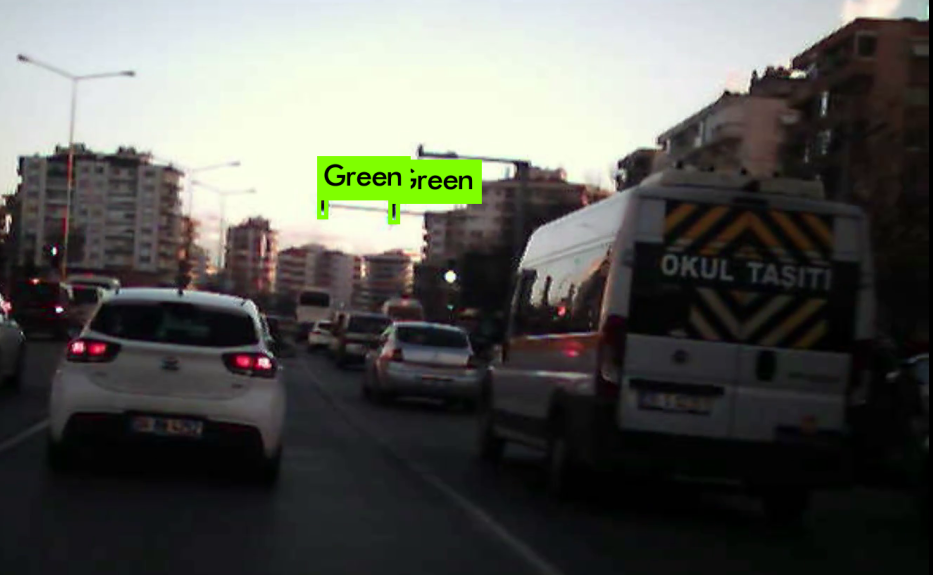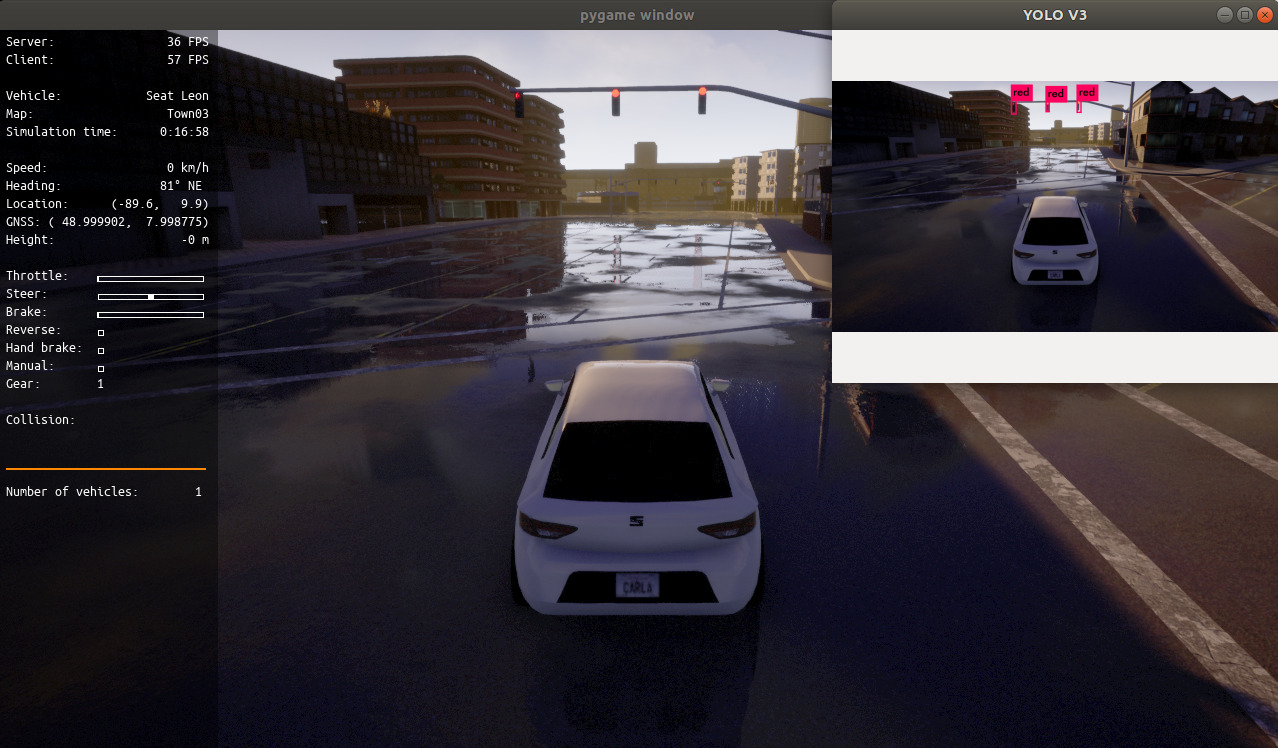YOLOv3 is a real-time object detection system, and it runs really fast on the CUDA supported GPUs (NVIDIA). So our aim is to train the model using the Bosch Small Traffic Lights Dataset and run it on images, videos and Carla simulator. Finally we will try it on NVIDIA Jetson Nano, which is a very small and capable SoC.
First start with downloading Bosch Small Traffic Lights Dataset:
https://hci.iwr.uni-heidelberg.de/node/6132
In order to download dataset we have to register and a code will be sent to our e-mail address:
Dataset is around 6 GB, so it will take a while to download it. When download is done you should be using 7-zip to open it (In Ubuntu Archieve Manager is not opening the zipped file!).
After extracting we see that we have 7 different folders and 5093 images which is a good number for training traffic lights.
Obviously we could write our own classifier, a Convolutional Neural Network (CNN), but then it will not be possible to run it realtime so we will use YOLOv3.
One of the best thing about YOLO is that it is running out of the box and supports well known datasets such as Pascal VOC, COCO and Open Images dataset. You can follow the YOLO offical page to proceed with setup and for more details. Let's clone and make it with:
git clone https://github.com/pjreddie/darknet
cd darknet
makeNow we need some example weights to run YOLO, download it from here and save it into darknet folder.
Now we can run an example:
./darknet detect cfg/yolov3.cfg yolov3.weights data/dog.jpgA result image will appear and we can see that YOLO found a dog, a bicycle and a truck. YOLO can be used for multiple images, with webcam and videos. I will not go into details here as you can follow the original YOLO website so I would like to show you how to prepare the dataset and train it.
As we already know that we need labels for the input images. In a standart CNN it would be a label for each image but since we are looking for parts of one image we need more than this. So YOLO is asking for a .txt file for each image as:
<object-class> <x> <y> <width> <height>Bosch Small Traffic Lights Dataset is coming with a Python script which turns the dataset into Pascal-VOC like dataset. It is good because YOLO has a script for converting VOC dataset to YOLO styled input. First clone the repository into the extracted dataset folder:
git clone git@github.com:bosch-ros-pkg/bstld.gitIf you already don't have SSH key and getting an error, you have to set one and link it to your Github account in order to clone this repository. You can follow Github tutorial for SSH.
Since images are in separate folders and it will be easier to manipulate them when they are in one folder let's put them all together under rgb/train/traffic_light_images folder.
mkdir traffic_light_images
find PATH_TO_DATASET/rgb/train/ -type f -print0 | xargs -0 --no-run-if-empty cp --target-directory=PATH_TO_DATASET/rgb/train/traffic_light_images/If you do not want to waste your space you should change 'cp' with 'mv' to move the images instead of making a copy of them. Now we have all the images under traffic_light_images folder.
Now create xmls folder and run:
mkdir traffic_light_xmlsNow go back to top bstld folder and run bosch_to_pascal.py script which will create necessary xml files for training with YOLO. Where first argument is PATH_TO_DATASET/train.yaml and second argument is /train/traffic_light_xmls folder which we recently created. Go back into the bstld folder:
python bosch_to_pascal.py ../train.yaml ../rgb/train/traffic_light_xmls/Now we have 5093 xml label files but we have to convert VOC to YOLO type labels with the script from darknet. So create a traffic_light_labels folder to /rgb/train/
mkdir traffic_light_labelsLet's go back to the darknet folder and create a folder named traffic-lights. We will put our files in this folder to reach them easily.
mkdir traffic-lights
cd traffic-lightsGo to darknet/scripts folder and make a copy of the voc_label.py and name it bosch_voc_to_yolo_converter.py under traffic-lights folder. This script will convert VOC type labels to YOLO type labels.
cp voc_label.py ../traffic-lights/bosch_voc_to_yolo_converter.pyimport xml.etree.ElementTree as ET
import pickle
import os
from os import listdir, getcwd
from os.path import join
import sys
sets=['traffic_lights']
classes = ["RedLeft", "Red", "RedRight", "GreenLeft", "Green", "GreenRight", "Yellow", "off"]
def convert(size, box):
dw = 1./(size[0])
dh = 1./(size[1])
x = (box[0] + box[1])/2.0 - 1
y = (box[2] + box[3])/2.0 - 1
w = box[1] - box[0]
h = box[3] - box[2]
x = x*dw
w = w*dw
y = y*dh
h = h*dh
return (x,y,w,h)
def convert_annotation(xml_path_input,file_folder,file_name):
in_file = open('%s'%(xml_path_input))
out_file = open('%s/%s.txt'%(file_folder,file_name), 'w')
tree=ET.parse(in_file)
root = tree.getroot()
size = root.find('size')
w = int(size.find('width').text)
h = int(size.find('height').text)
for obj in root.iter('object'):
difficult = obj.find('difficult').text
cls = obj.find('name').text
if cls not in classes or int(difficult)==1:
continue
cls_id = classes.index(cls)
xmlbox = obj.find('bndbox')
b = (float(xmlbox.find('xmin').text), float(xmlbox.find('xmax').text), float(xmlbox.find('ymin').text), float(xmlbox.find('ymax').text))
bb = convert((w,h), b)
out_file.write(str(cls_id) + " " + " ".join([str(a) for a in bb]) + '\n')
wd = getcwd()
output_folder = str(sys.argv[1])
xmls_list = str(sys.argv[2])
images_folder = str(sys.argv[3])
for image_set in sets:
if not os.path.exists(output_folder):
os.makedirs(output_folder)
xml_paths = open(xmls_list).read().strip().split()
list_file = open('%s.txt'%(image_set), 'w')
for xml_path in xml_paths:
#print("xml path: ",xml_path)
xml_name = xml_path.split('/')[-1]
#print("xml name:",xml_name)
image_name = xml_name.split('.')[0]
#print("image name: ",image_name)
#print(images_folder+'/%s.png\n'%(image_name))
list_file.write(images_folder+'/%s.png\n'%(image_name))
convert_annotation(xml_path,output_folder,image_name)
list_file.close()Here we have to change classes names with our class names. And as arguments we have to give output_folder for .txt files, xmls_list which is a .txt file that has the paths to the xml files and images folder path which we are going to use for training.
We will use the folder PATH_TO_DATASET/rgb/train/traffic_light_labels for outputs, PATH_TO_DATASET/rgb/train/traffic_light_images for training images and we also need a .txt file which keeps the
Now go to the cfg folder. Make a copy of the voc.data and name it voc-bosch.data .
cp voc.data ../traffic-lights/voc-bosch.dataOpen it:
classes= 20
train = /home/pjreddie/data/voc/train.txt
valid = /home/pjreddie/data/voc/2007_test.txt
names = data/voc.names
backup = backupclasses shows the number of the labels we would like to classify. From the dataset we can see that main lights are RedLeft, Red, RedRight, GreenLeft, Green, GreenRight, Yellow and off. Feel free to add or extract the ones you like. So our classes will be '8'. train.txt and test.txt are the text files which has the paths of the image files. names, are labels' names and as mentioned before we should get them from the database.
Let's copy the data/voc.names to traffic-lights and name it voc-bosch.names:
cp voc.names ../traffic-lights/voc-bosch.namesand replace the items with:
- RedLeft
- Red
- RedRight
- GreenLeft
- Green
- GreenRight
- Yellow
- off
We need the paths of the .xml files as a list in a .txt file, in order to get it we will write a little Python script:
import os
import sys
xmls_path = sys.argv[1] #xml files path
xml_files = []
#r = root, d = directories, f = xml_files
for r,d,f in os.walk(xmls_path):
for file in f:
if '.xml' in file:
xml_files.append(os.path.join(r, file)) #Gets the whole file xmls_path
#xml_files.append(os.path.splitext(file)[0]) # Gets only the name of the file without extension,path etc.
file_num = len(xml_files)
print("Length of the .xml xml_files: ", file_num)
if not open('bosch_traffic_light_xmls_list.txt','w'):
os.makefile('bosch_traffic_light_xmls_list.txt')
labels = open('bosch_traffic_light_xmls_list.txt','w')
for xml in xml_files:
labels.write(xml + '\n')
labels.close()
#for f in xml_files:
#print(f)Name it "make_xml_list.py" and run it:
python make_xml_list.py PATH_TO_DATASET/rgb/train/traffic_light_xmls/It will create traffic_lights/bosch_traffic_light_xmls_list.txt file.
We have to create train.txt and test.txt which are list of the paths' of the relative images. Write a basic splitter script named train_test_split.py:
import glob, os
import numpy as np
from sklearn.model_selection import train_test_split
import sys
image_paths_file = sys.argv[1] #traffic_lights/traffic_lights.txt
# Percentage of images to be used for the test set (float between 0-1)
percentage_test = float(sys.argv[2]);
img_paths = []
img_paths = open(image_paths_file).read().strip().split()
X_train, X_test= train_test_split(img_paths, test_size=percentage_test, random_state=31)
with open('train.txt', 'a') as train_file:
for train in X_train:
train_file.write(train + '\n')
with open('test.txt', 'a') as test_file:
for test in X_test:
test_file.write(test + '\n')It takes recently created traffic_lights.txt file as first argument and second argument split percentage between 0 to 1.
python train_test_split.py traffic_lights.txt 0.2test.txt and train.txt is created.
Create a backup folder inside traffic-lights folder where we will save our weights as we train:
mkdir backupStart updating the voc-bosch.data:
classes= 8
train = traffic-lights/train.txt
valid = traffic-lights/test.txt
names = traffic-lights/voc-bosch.names
backup = traffic-lights/backupNow we need one more thing to do to start training. Go back to the darknet folder and get into the cfg folder. Make a copy of the yolov3-tiny.cfg into traffic-lights folder and name it yolov3-tiny-bosch.cfg .
cp yolov3-tiny.cfg ../traffic-lights/yolov3-tiny-bosch.cfgOpen it:
You will see line 5,6,7 is commented out, uncomment them:
Training
batch=64
subdivisions=2filters= 3 x (5 + #ofclasses)filters = 3 x (5+8) = 39
Change filters' size before '[yolo]' parameters (lines 127 and 171) with 39 and classes to 8 in '[yolo]' parameters (lines 135 and 177).
We will use the technique called transfer learning where we use the pre-trained VOC data and just change the end of the deep-neural-network.
Download weights of the darknet53 model and train:
./darknet detector train traffic-lights/voc-bosch.data traffic-lights/yolov3-tiny-bosch.cfg ../darknet53.conv.74After training done (after 30000 images results are getting sufficient) try it with:
./darknet detector demo traffic-lights/voc-bosch.data traffic-lights/yolov3-tiny-bosch.cfg traffic-lights/backup/yolov3-tiny-bosch_40000.weights <video file>Let's try our classifier with a video:
./darknet detector demo traffic-lights/voc-bosch.data traffic-lights/yolov3-tiny-bosch.cfg traffic-lights//backup/yolov3-tiny-bosch_40000.weights <video file>Videos are good for showing the results but we need something more interactive which makes Carla simulator a great choice. Carla has built in ROS connections so it makes it even better for our case. Follow the instructions on the website to start using Carla. We can write our own nodes for traffic light detection but still we would like to use YOLO for classifcation. Since we have weights, cfg and data files, we can use them with this leggedrobotics/darknet_ros repository that combines YOLO and ROS and makes our lives easier.
Once we clone the darknet_ros repository follow the instructions and run Carla server with:
cd ~/UnrealEngine_4.22/carla/Dist/CARLA_Shipping_0.9.6-27-g8e2a15f3/LinuxNoEditor'
carla_srv_run='./CarlaUE4.sh -carla-server -windowed -ResX=320 -ResY=240 -benchmark -fps=10'Clone, make and launch carla_ros_bridge:
roslaunch carla_ros_bridge carla_ros_bridge.launchGo to the carla/PythonAPI/examples folder and run:
python manual_control.py --rolename=ego_vehicleFinally launch darknet_ros:
roslaunch darknet_ros darknet_ros.launch image:=/carla/ego_vehicle/camera/rgb/front/image_colorA new window will pop and show if any traffic lights are classified.
- YOLOv3 Website
- BOSCH Traffic Lights Dataset
- Bosch Small Traffic Lights Dataset Github Repository
- LearnOpenCV, Training YOLOv3 : Deep Learning based Custom Object Detector
- EMARAIC, How to build a custom object detector using YOLOv3 in Python
- Deep Learning based Object Detection using YOLOv3 with OpenCV ( Python / C++ )
- YOLO ROS: Real-Time Object Detection for ROS Github Repository
- Anchor Calculation Explained
- Carla ROS bridge
- Study and Adaptation of the Autonomous Driving Simulator CARLA for ATLASCAR2




